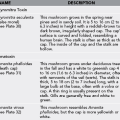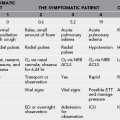Lightning Injuries
Disorders
Box 9-1 lists the types of immediate injuries that can occur with any of the effects of lightning, which is best described as a unidirectional massive current impulse.
Signs and Symptoms
1. Generally, a history of a lightning strike or near strike
2. Disarray of clothing and belongings
3. Lichtenberg figure (pathognomonic sign of lightning injury that self-resolves and needs no treatment) (see Plate 5)
4. Linear or punctate (see Plate 6) burns with tympanic membrane rupture and confusion in an outdoor setting
5. Confusion, amnesia, or unconsciousness in a person found indoors after or during a thunderstorm
6. Muscle aches and body tingling
7. Keraunoparalysis (a temporary self-resolving state characterized by skin mottling, extremity paralysis, and diminished or absent extremity pulses)
Treatment
Note that lightning victims are not “charged” and thus pose no hazard to rescuers.
1. Assess and treat first those victims who appear dead, because they may ultimately recover if properly resuscitated.
a. As with any cardiac arrest, the first steps are addressing chest compressions (circulation), airway, and breathing.
b. Perform cardiopulmonary resuscitation (CPR) if indicated. If no pulse is obtained within 20 to 30 minutes of initiating resuscitation, it is reasonable to stop CPR. However, be aware that dilated pupils should not be taken as the sole sign of brain death in the lightning victim.
c. If you successfully obtain a pulse with CPR, continue ventilation until spontaneous adequate respirations resume, the person is pronounced dead, continued resuscitation is deemed not feasible, or you are in danger.
2. Stabilize and splint any fractures.
3. Be aware that the patient may have been thrown a considerable distance by the strike. Initiate and maintain spinal fracture precautions if indicated.
4. Administer oxygen and intravenous fluids if available. Apply a cardiac monitor if available.
Prevention
1. Lightning may travel nearly horizontally as far as 10 miles (16 km) or more in front of a thunderstorm. When a thunderstorm threatens, seek shelter in a substantial building or inside a metal-topped vehicle (not a tent or a convertible automobile). If you are in a car, roll up all windows and stay in it. If it is a convertible and there is no other shelter, huddle on the ground at least 45 m (49 yards) away from the vehicle.
2. If you are in a tent, stay as far away from the poles and wet tent material (e.g., fabric) as possible.
3. Do not count on rubber-soled shoes or raincoats to provide protection. Similarly, the rubber tires on a car do not provide any protection. Electrical energy travels along the outside of the car body and dissipates into the ground.
4. Do not stand under a tall tree in an open area or on a ridge or hilltop.
5. Move away from open water, and do not stand near a metal boat. If you are swimming, get out of the water.
6. Move away from tractors and other metal farm equipment. Avoid tall objects, such as ski lifts, boat masts, flagpoles, and power lines.
7. Get off motorcycles, bicycles, and golf carts. Put down golf clubs, umbrellas, and fishing poles.
8. Stay away from wire fences, clotheslines, metal pipes, and other metallic paths that could carry lightning to you from a distance.
9. Avoid standing in small, isolated sheds or other small structures in open areas.
10. Once you are indoors, avoid being near windows, open doors, fireplaces, or large metal fixtures. Be aware that a cellular telephone can transmit loud static that can cause acoustic damage.
11. In a forest, seek shelter in a low area under a thick growth of saplings or small trees. Avoid the tallest trees, staying a distance from the tree at least equal to the tree’s height. Avoid the entrances to caves.
12. In an open area, go to a low place such as a ravine or valley.
13. If you are totally in the open:
a. Stay far away from single trees to avoid lightning splashes.
b. Drop to your knees and bend forward, putting your hands on your knees.
c. If it is available, place insulating material (e.g., sleeping pad, life jacket, rope) between you and the ground. Do not lie flat on the ground.
14. If your hair stands on end, you hear high-pitched or crackling noises, or you see a blue halo around objects, there is electrical activity around you that typically precedes a lightning strike. If you can, leave the area immediately. If you are unable to do this, crouch down on the balls of your feet and tuck your head down. Do not touch the ground with your hands.
15. When a thunderstorm is about to pass, maintain a cautious approach because this continues to be a dangerous time.






